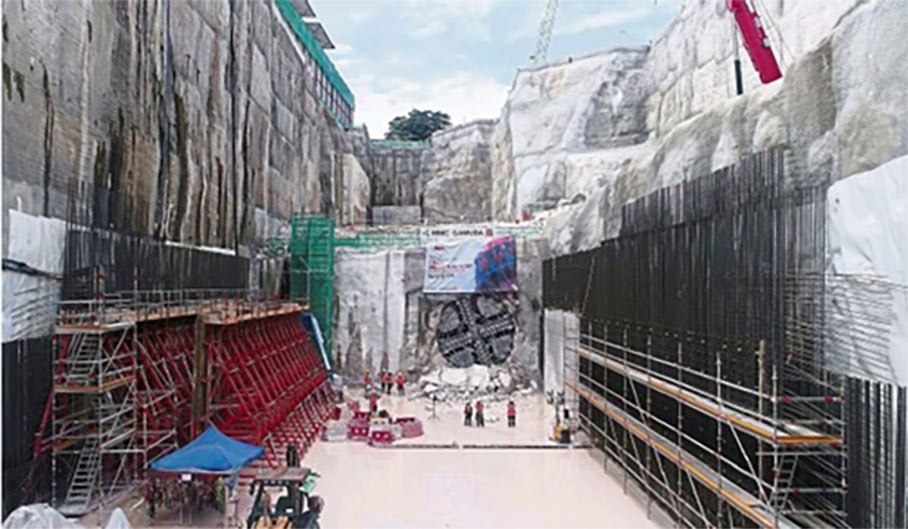After earlier threats to terminate the underground construction contract of the new metro Line 2 of the Klang Valley MRT in Kuala Lumpur, the MMC-Gamuda construction team have achieved the first of 16 TBM breakthroughs for the project with a second due by mid-March. MMC-Gamuda is to use 12 TBMs to complete 16 drives to excavate the 11.5km long twin tube running tunnels between 11 underground station boxes and an open cut crossover structure for the new 52.2km long Line from Sungai Buloh in the north to Putrajaya Sentral in the south (Figs 1 and 2).

The first TBM launched on the project in March 2018 from the Bandar Malaysia North station box and broke through into the Chan Sow Lin station box on 29 January. Its twin drive machine is expected to breakthrough at Chan Sow Lin by about 15 March 2019.
The first breakthrough machines are two of eight refurbished Herrenknecht variable density slurry machine (VDMs) that were used successfully by MMC-Gamuda to excavate the 9.5km-long underground section with seven underground stations of the city’s KVMRT Line 1 between early 2013 and April 2016. Another four new VDMs, are also delivered to the project by Herrenknecht.
“We are now quite busy, progressing machines and preparing others for launch,” explained Gus Klados, Tunnelling Director for the MMC-Gamuda JV on Line 2 and also for the JV for Line 1 before it. “The machines breaking into Chan Sow Lin station box will relaunch after a maintenance overhaul from the opposite end-wall to complete the twin drives to Tun Razak Station box. We have also launched a TBM from Titiwangsa Station box in the north, heading southwards and the second machine in the twin drive will launch soon. Another TBM has launched from the same Titiwangsa Station box heading northwards to the north portal and its twin will launch in March. We have also launched the two machines from the crossover construction box, between Titiwangsa Station and Ampang Park Stations, heading southwards towards breakthroughs into the Ampang Park Station box. We have now launched or are ready to launch eight machines, with another four to assemble and launch by mid-year from the Conlay Station box to head towards Tun Razak Station and to Ampang Park. There will be few projects in the industry where 12 TBMs are being operated simultaneously by the same contractor to complete 16 separate drives.”
The first two machines from Bandar Malaysia North to Chan Sow Lin operated frequently in the high slurry density option through the prevailing karstic limestone. Geological conditions on Line 2 are known to be more problematic than conditions encountered on Line 1 for which the variable density TBMs were developed. Increasing the density of the slurry in the excavation chamber provides a thicker bentonite medium that is less likely than the traditional thinner slurry mediums, to travel through karstic features and fissures and cause slurry blowouts on the surface of the streets above.
“The fact is the underground alignment for Line 2 is more difficult to design and build compared to the Line 1 alignment,” reported Dr Ooi Lean Hock, head of the MMC-Gamuda geotechnical department. “In addition to karst features, the TBMs from Bandar Malaysia North to Chan Sow Lin also had to contend with folded limestone in which the synclines and anticlines had many cracks and fractured zones that make managing face pressures more difficult to regulate.”
On their drives from Bandar Malaysia North to Chan Sow Lin the VDMs successfully passed 20m under the 14-lane Jalan Sungai Besi highway and 25m under the Ampang LRT rapid rail line without causing any concerns or holdups on either.
In the meantime, the MMC-Gamuda management team is negotiating with MRT Corporation and the Government to convert its existing Project Management Contract (PDP) and its Underground Works Design and Build contract into a turnkey contract. The contractual adjustment is required as part of a project cost saving exercise negotiated between MMC-Gamuda and the Government to reduce the original 16.71 billion Ringgit (MYR) underground contract by a total of MYR 3.6 billion, or 21.5%, to MYR13.11 billion or from US$3.99 billion by $860,000 to $3.1 billion. Cost savings also postpone finishing works of the excavated and structurally built Bandar Malaysia North and Bandar Malaysia South Stations to a future as yet undefined date and under a different contract. With these agreements, the total cost of the MRT Line 2 is reduced by MYR 8.82 billion, or 22.4%, from MYR 39.35 billion to MYR30.53 billion (a 22.4% $2.1 billion saving from US$9.4 billion to US$ 7.3 billion).
With breakthrough of the first TBM on the project and progress now started for seven other machines, and all of the station boxes excavated, construction of Line 2 of the metro project is reported as now more than 41% completed. The elevated phase one of the new Line, from the Sungai Buloh Station to Kampung Batu Station, is scheduled to begin operations in July 2021, with the rest of the line from Kampung Batu Station, through the underground section and on to the Putrajaya Sentral Station in the south for Phase Two, expected to be operational in July 2022.
|
|
|
|
|